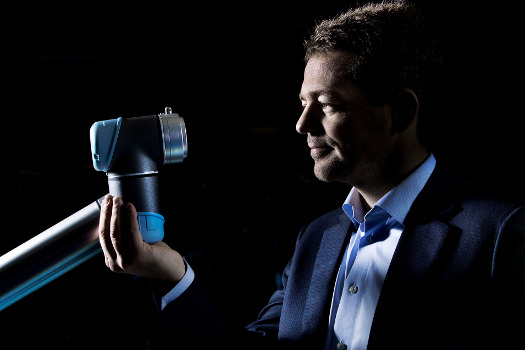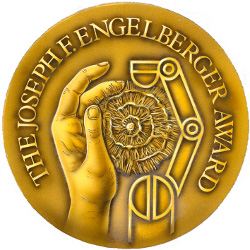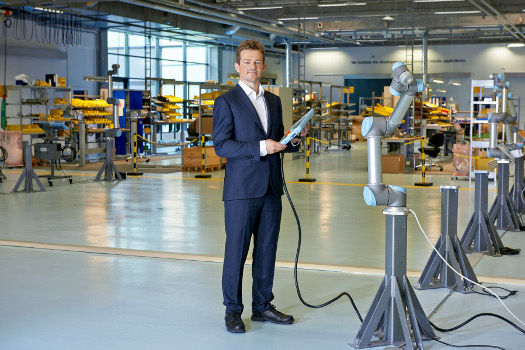 |
| June 05, 2018 | Volume 14 Issue 21 |
Designfax weekly eMagazine
Archives
Partners
Manufacturing Center
Product Spotlight
Modern Applications News
Metalworking Ideas For
Today's Job Shops
Tooling and Production
Strategies for large
metalworking plants
Universal Robots' CTO wins 'Nobel Prize of Robotics' for pioneering cobots

Esben Østergaard will accept the Engelberger Robotics Award on June 20.
The Robotic Industries Association (RIA) recently announced Esben Østergaard, CTO of Universal Robots, as the recipient of the Engelberger Robotics Award. Østergaard spearheads the development of UR's collaborative robot arms, representing one of the most significant technology breakthroughs coming out of the robotics community in decades. The Engelberger Awards Dinner and Ceremony will be held at 6:30 pm on Wed., June 20, 2018, at the Hofbräuhaus in Munich, Germany, as part of Automatica and the International Symposium on Robotics.

The award is named for Joseph F. Engelberger, known throughout the world as the "father of robotics." Engelberger was founder and president of Unimation, Inc., the world's first industrial robot manufacturer. Since 1977, the Engelberger Robotics awards have been presented to individuals for excellence in technology development, application, education, and leadership in the robotics industry, and to recognize outstanding individuals from all over the world.
RIA President Jeff Burnstein calls the Universal Robots CTO a visionary in defining a new category of robotics. "His work in the field of collaborative robot applications has allowed robots to enter previously unthinkable sectors in just about every industry," says Burnstein. "Østergaard's emphasis on robots that work side-by-side with people and are easy to use has created enormous interest among many small and medium-sized companies who never even considered robots before. In a world that is increasingly characterized by people and robots working together, Esben's pioneering technology advances play a pivotal role."
Universal Robots' 2008 launch of the world's first commercially viable robot able to operate safely outside enclosures alongside people came at great financial risks in a market unaccustomed to human-robot collaboration. Yet Østergaard and his team prevailed by offering the industry a robot that was not only safe to work with but also lightweight, easy to use, and flexible. These accomplishments have placed Universal Robots as the unrivaled market leader of collaborative robots -- also referred to as "cobots" -- with a current 58 percent share of all cobots sold worldwide, posting a rapid 72 percent growth in 2017.
"I'm deeply honored to win the award named after Joseph Engelberger, who revolutionized industrial manufacturing with robotics," says Østergaard. "Engelberger's view that a robot should be able to handle a range of tasks in a factory aligns with Universal Robots' core mission, and I'm a great admirer of his work."

Østergaard's UR cobots can be easily programmed via an intuitive tablet interface.
Østergaard leads a team of developers that became the first to launch user-friendly, yet sophisticated, 3D robot programming via an intuitive tablet interface. This has enabled users with no previous programming experience to quickly set up and operate the UR robots.
He also developed the robot's force and safety control features, which ensure that if the robot collides with a person, the robot automatically stops operating and does not cause bodily harm, adhering to the current safety requirements on force and torque limitations. These features have eliminated the need for safety guarding in a vast majority of the UR robot applications currently installed and remain a trailblazer for the "collaborative robot" concept.
Safety, however, according to Østergaard, is just "the cost of entry" in the cobot market. He continues to propel UR's frontrunner position by constantly raising the bar for what the term "collaborative" entails. The label not only means humans can collaborate directly with the robots, but with no safety guard between them. The term also addresses the ease of use; a robot is not truly collaborative if it's not affordable and easy to work with.
"We want to place control of factory automation back into the hands of operators. Instead of replacing people, we want to give them a tool to do their work more efficiently," says Østergaard. "We want to remove them from working like robots to becoming robot programmers and handling more value-added tasks. Doing this will perhaps be the best long-term result derived from leveraging collaborative robots."
Esben Østergaard calls this new era the 5th industrial revolution.
"This redeployment of human creativity interspersed with the robot's repeatability addresses the market evolvement and customer requirements demanding a high degree of product individualization. It's qualitative change both in the products made and for the people making them," he says.
Source: Universal Robots
Published June 2018
Rate this article
View our terms of use and privacy policy
